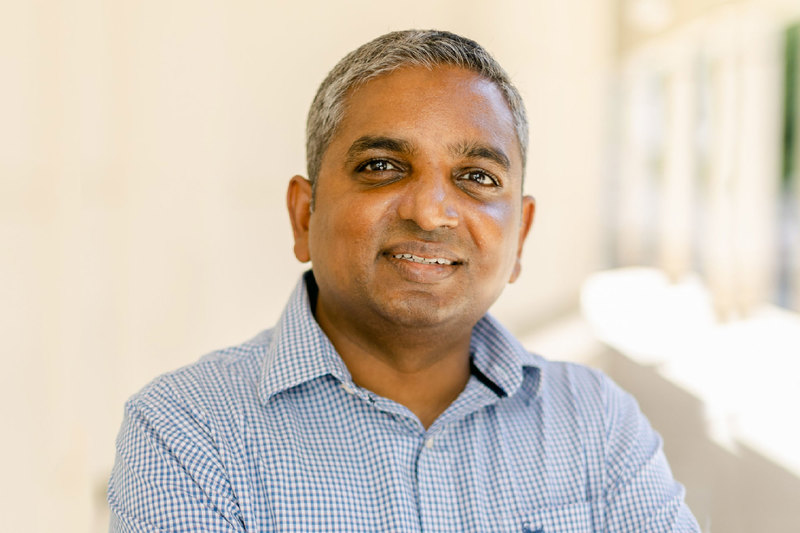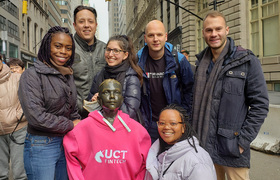UCT academic appointed SARChI Chair in Artificial Intelligence Systems
26 July 2023 | Story Katherine Wilson. Photo Supplied. Read time 8 min.
The University of Cape Town’s (UCT) Associate Professor Deshen Moodley was recently awarded the South African Research Chairs Initiative (SARChI) Chair in Artificial Intelligence (AI) Systems. This is the first SARChI Chair at UCT under the Department of Science and Innovation / National Research Foundation’s (DSI/NRF) new SARChI co-funding framework.
Associate Professor Moodley’s research focus is on AI systems – specifically human-centred AI systems. This is a field which is in the spotlight, prompting the questions: “Will AI replace us?” and “Where do we fit in?”
“Many people think of AI systems as autonomous and are concerned that they will replace humans; however, the whole idea behind augmented AI are AI systems that work collaboratively and in tandem with humans, where the machine and human establish a seamless partnership with the AI amplifying human performance rather than replacing it,” he said.
Google Maps as an example of AI
According to Moodley, Google Maps is a good example of AI and how it developed in this augmented fashion. This GPS service does dynamic planning; in real time it understands traffic patterns, makes estimates and updates your route continuously, giving accurate predictions of time of arrival, among other things. This is an example of incredible modelling and sophisticated technology which has augmented our reality and freed us up to do other things. We have become reliant on Google Maps and it is now seamlessly integrated into our daily lives. For instance, city planners can see from AI where traffic bottlenecks exist and address those issues. What is fascinating, is human behaviour while engaging with AI and Moodley describes how people talk to the Google Maps voice, interact with it, and sometimes disagree or argue with it.
Advantages and Disadvantages of AI
AI has the capacity to amplify what we do and free people up to focus their cognitive energy and capacity on other things. AI has brought change, and for some people rapid change can be uncomfortable, but it can also reduce anxiety and stress, tell you where there will be a problem and free up some cognitive cycles so that you can focus on other things. What is interesting is that people don’t endow Google Maps with AI properties, probably because they are so familiar and comfortable with it. Furthermore, through the use of Google Maps, our spatial reasoning is changing: the next generation may not be able to read traditional paper maps and will develop their spatial reasoning skills in a new and different way. This change brought on by a disruptive technology is not new, eg the calculator brought about a similar change to arithmetic. But we live in a fluid and rapidly changing world – and we can either choose to embrace the change or be fearful of it, said Moodley.
AI and 3D digital twins
Moodley is interested in how AI can enable other disruptive technologies, eg the emerging area of digital twins, where we have a pseudo reality in a 3D virtual world which attempts to replicate and synchronise real-world physical and social entities, and systems in real-time – and links closely with the idea of the metaverse. This 3D virtual world can mimic reality and has diverse smart city applications.
“AI-driven 3D digital twins can be leveraged to develop new approaches for public health monitoring and simulation.”
This is an exciting area which is already gaining traction, eg WESGRO has created a virtual 3D model of Table Mountain that people can use to explore the mountain without actually visiting it. This approach provides the capability for simulating not just physical entities in a city, but also to simulate people, their activities and interactions. It will produce a new platform to not only change how people are entertained, but how they interact with the physical world and with each other. He is particularly interested in exploring the potential of digital twins (a 3D representation of reality) and AI to bring about fundamental change in public health in low-resource African settings. AI-driven 3D digital twins can be leveraged to develop new approaches for public health monitoring and simulation, for examining how epidemics evolve and for improving our overall health and well-being.
Leveraging new approaches in deep learning
Moodley has a long history of working in the public health space and said that using a 3D twin approach can radically change traditional approaches for modelling and simulation, especially for predictive modelling and to deepen our understanding of human behaviour. It can bring about a shift from curative health, which is the thrust of the current system, towards a system focused more on preventative health. With this approach, he explained that this will also fundamentally change health research and knowledge production, where researchers publish and share not just their data, but also their models and code. His research looks at AI systems that are both adaptive and cognitive (align with how humans think). The adaption mechanisms incorporate powerful pattern recognition and predictive modelling techniques. In the area of deep learning new techniques, such as spatial-temporal graph neural networks, have emerged over the last two years. These techniques, which learn complex and erratic spatial temporal dependencies, outperform older deep learning methods in dynamic spatial-temporal applications, and are now established for crowd flow modelling and prediction applications, such as vehicle traffic and the movement of people in urban environments. These techniques have high potential for real-time prediction of human movement, interactions and activities in urban environments based on noisy and incomplete sensor observations.
Health monitoring
One of his PhD students is currently looking at how AI systems can be used for continuous personal health monitoring and wellness applications using low-cost wearables. This is showing positive outputs for building individualised health models for health monitoring and prediction. One of the exciting new findings in this area is that a person’s emotional state can now be estimated from a low-cost ECG reading – which holds promise for mental health and well-being applications. This capacity to not only be able to access physiological characteristics, but to understand the mind–body continuum and emotional states through AI-enabled analysis of heart signals is a promising and exciting development.
An African future using AI
One of the key things that Moodley highlighted is that all the big ideas in AI, such as a robot scientist for scientific knowledge discovery, should not only come from the Global North – the Global South should be providing perspective, systems and ideas. This links into UCT’s Vision 2030. He stressed that we need to be proactive and ask how we can shape an African future using AI. With this in mind, he emphasised the need for cross-faculty, university-wide workshops on AI; increasing the visibility of AI; and working with other universities in South Africa.
 This work is licensed under a Creative Commons Attribution-NoDerivatives 4.0 International License.
This work is licensed under a Creative Commons Attribution-NoDerivatives 4.0 International License.
Please view the republishing articles page for more information.










